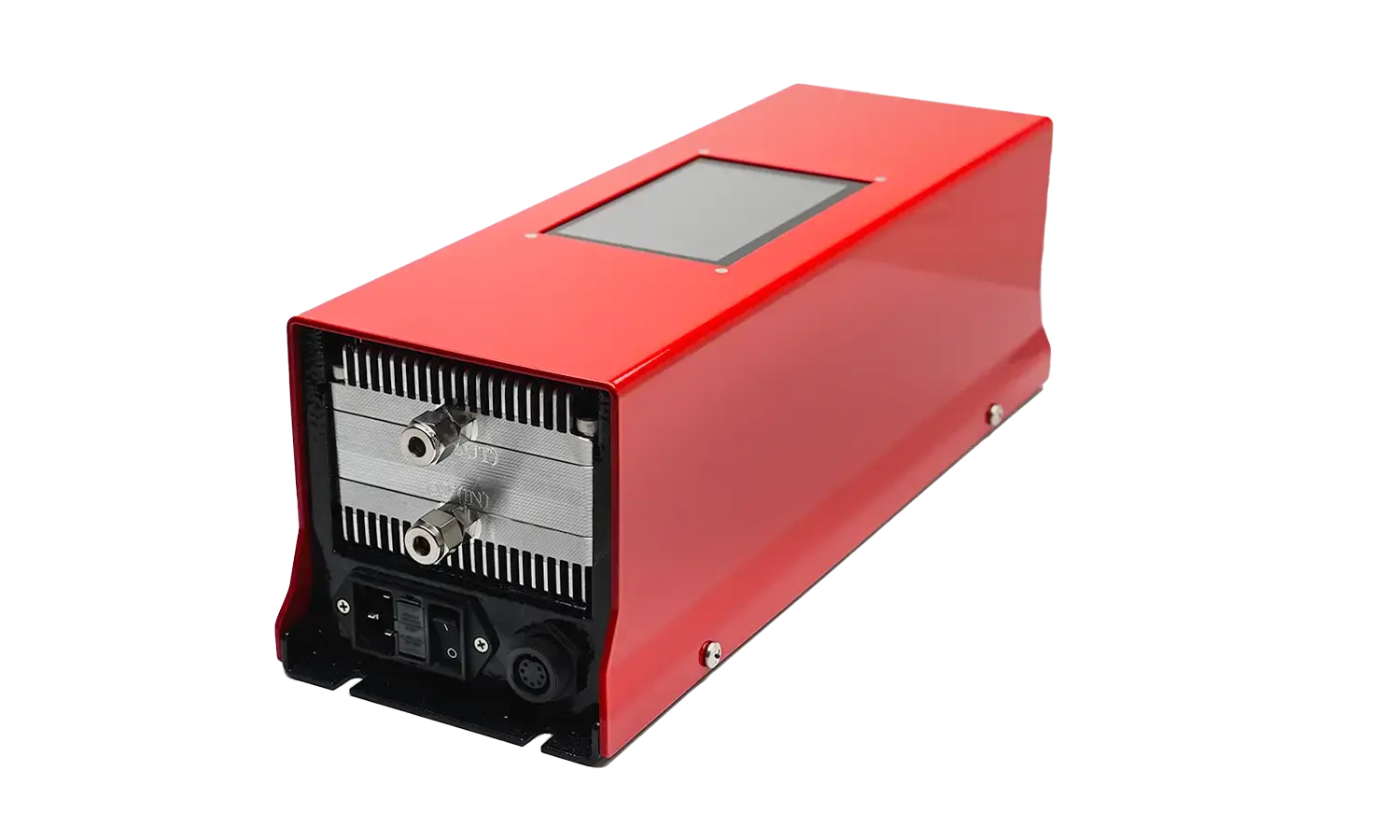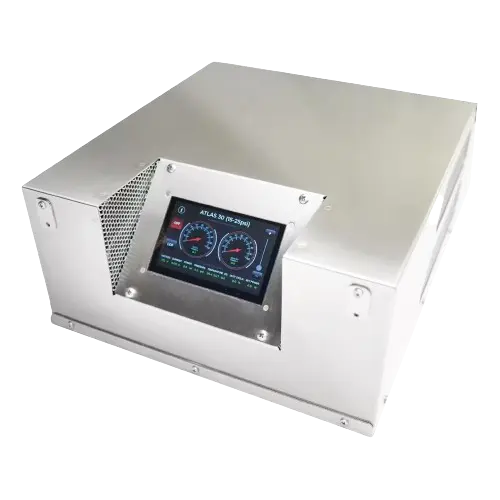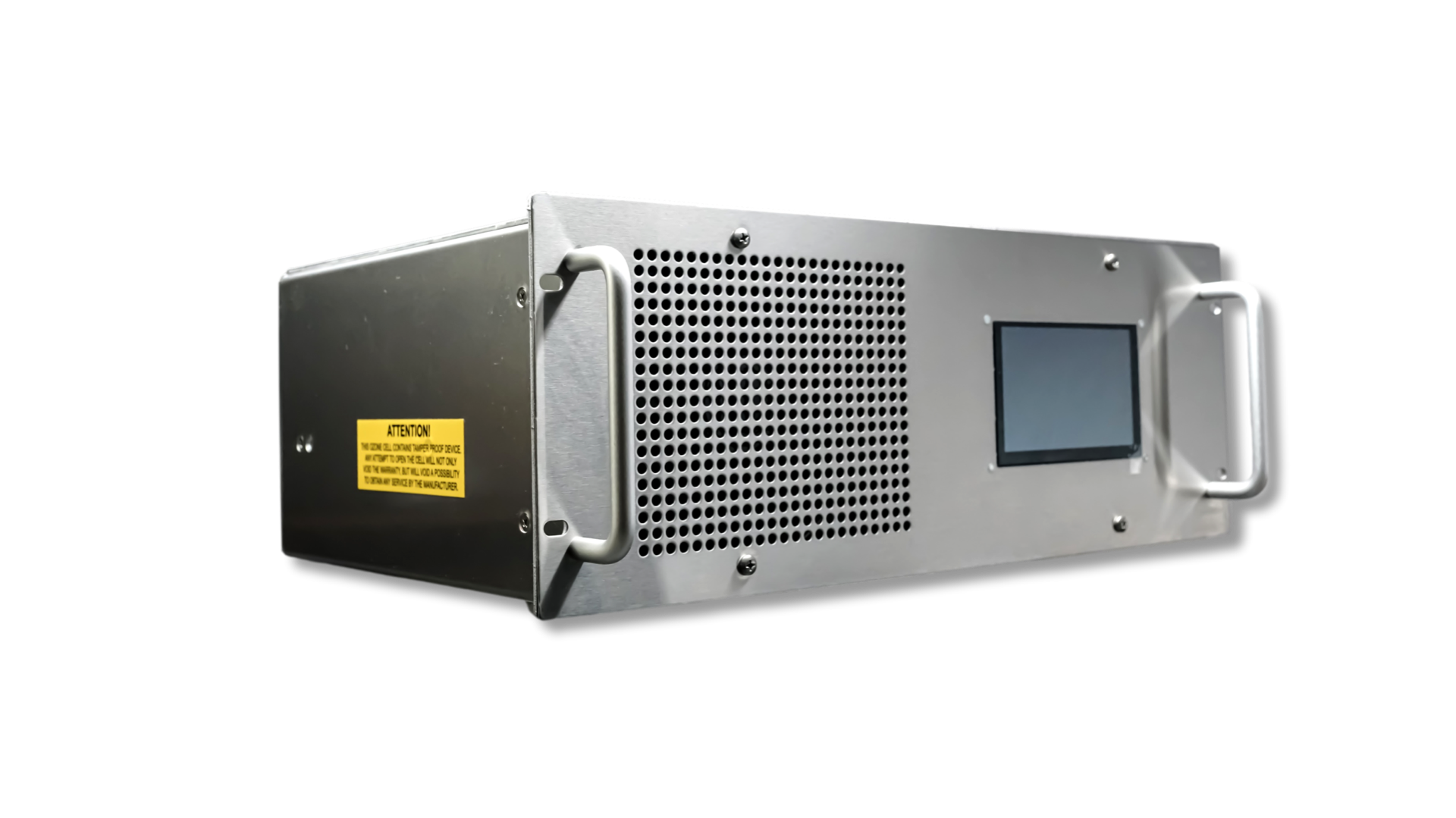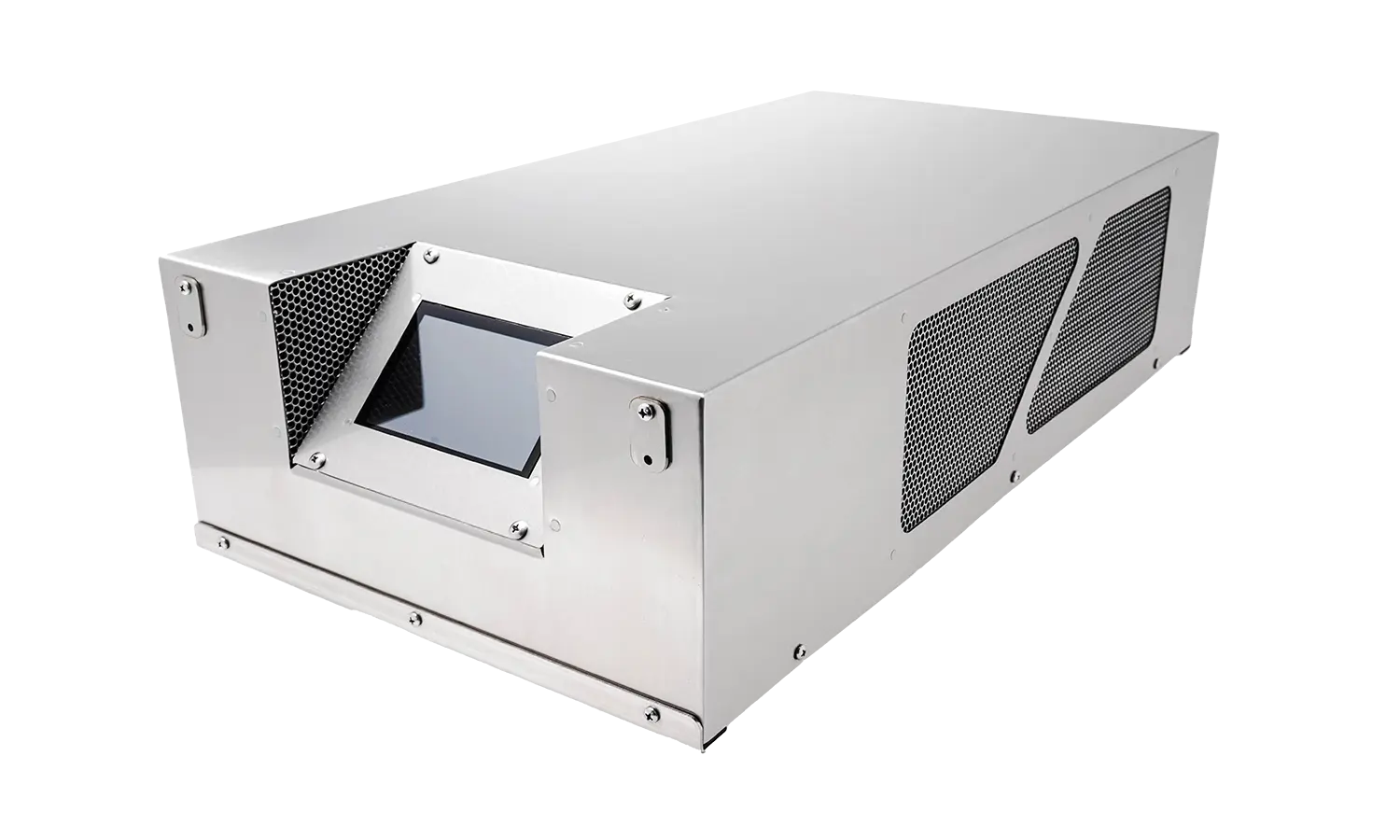Share This Story, Choose Your Platform!
Introduction to Ozonation
Ozonation is the process of introducing ozone gas (O3) into a substance, typically water, to purify and disinfect it. Ozone is an unstable form of oxygen (O2) that has a powerful oxidizing effect, which makes it effective at destroying a wide range of pollutants and harmful microorganisms such as bacteria, viruses, and algae. Ozonation replaces chlorine and other chemical disinfectants in water treatment, as ozone treatment is an environmentally friendly and efficient alternative.
What is Ozone?
Ozone is a triatomic form of oxygen with the chemical formula O3. Its three oxygen atoms strongly influence its reactivity, the extra oxygen atom can easily attach to other substances. That means ozone is an unstable molecule that decomposes into oxygen molecules. So, It must be generated on-site as used. The Typical half-life of ozone at 20 C is 3 days and 20 minutes when ozone is dissolved in water.
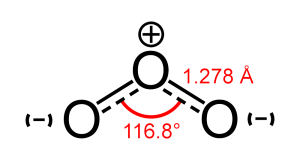
Ozone Generation
Industrial ozone generation is typically done using a process in which high-voltage electrical energy is applied to an oxygen-rich gas mixture. It is simply a diffused spark through a dielectric to spread out the electrical discharge to a large area. In this method, the electric charge applied to the electrodes causes some oxygen molecules to split apart and temporarily combine with other oxygen molecules making a molecule of three oxygen atoms (O3).
How does Ozone work in water treatment?
The ozonation process involves introducing ozone gas into the water being treated. This can be done using a venturi injector to dissolve ozone directly into the water. Once the ozone is in the water, it reacts with the contaminants and pollutants, breaking down their chemical structure and rendering them harmless. Ozone is a strong oxidant and virucide widely used for drinking water disinfection and wastewater treatment plants. The effectiveness of a biocide in the ozonation system is normally described by its concentration-time or CT value which is defined as a product of the average concentration of ozone(residual ozone) multiplied by the exposure time
What is Ozonated water?
Ozonated water is water that has been infused or treated with ozone (O3). It readily reacts with other substances, often breaking them down or neutralizing contaminants. When ozone is introduced into water, it serves several purposes, including:
- Disinfection: Ozonated water is commonly used as a disinfectant because ozone kills bacteria, viruses, and other microorganisms. It can be used in water treatment plants, swimming pools, and even for cleaning and sanitizing purposes in various industries.
- Wastewater Treatment: Ozone can be employed in wastewater treatment to break down organic and inorganic pollutants, making the water cleaner and safer for the environment.
- Food and Beverage Processing: Ozonated water is sometimes used in the food and beverage industry to sanitize and disinfect food products, equipment, and packaging.
- Drinking Water Treatment: Some municipalities use ozone as part of their drinking water treatment process to disinfect and remove impurities from the water supply.
- Laundry and Cleaning: Ozonated water can be used in commercial laundry operations and industrial cleaning processes due to its sanitizing and stain-removing properties.
Chemical Properties of Ozone
Ozone is a very strong oxidant and virucide widely used for disinfection; Ozone destroys bacteria by directing protoplasmatic oxidation, resulting in cell wall disintegration.
- Ozone is an excellent broad-spectrum oxidizing.
- Ozone is a strong chemical oxidant
- Reduces the toxicity of organic compounds
- can be combined with UV or Peroxide to generate hydroxyl radicals to create an advanced oxidation process
The effectiveness of a biocide in the ozonation system is normally described by its concentration-time or CT value which is defined as a product of the average concentration of ozone( residual) multiplied by the exposure time
Ct values (min · mg/L) for 4-log inactivation of viruses
| Inactivation by | Temp 5ºC | Temp 10ºC | Temp 20ºC | Temp 25ºC |
|---|---|---|---|---|
| Chlorine dioxide | 33.4 | 25.1 | 12.5 | 8.4 |
| Ozone | 1.2 | 1 | 0.5 | 0.3 |
Ct values (min · mg/L) for 3-log inactivation of Giardia cysts
| Inactivation by | Temp 5ºC | Temp 10ºC | Temp 20ºC | Temp 25ºC |
|---|---|---|---|---|
| Chlorine dioxide | 26 | 23 | 15 | 11 |
| Ozone | 1.9 | 1.43 | 0.72 | 0.48 |
Source: Water and Wastewater Engineering: Design Principles and Practice, Mackenzie L.
For the table, we can see ozone has the lowest CT values which mean needs the least amount of exposure time or the least amount of biocides to inactivate virus or bacteria
Check this interesting article about ozone vs chlorine for water disinfection
Benefits of Ozonation for Water Purification
Ozonation is an efficient and effective way to purify water, and it offers a range of benefits over traditional methods such as chlorination. Here are some of the key benefits of ozonation for drinking water purification:
- Powerful Disinfection: Ozone is a highly reactive oxidizing agent, which makes it effective at destroying a wide range of pathogens, including bacteria, viruses, and algae. It is also effective at destroying other harmful contaminants such as pesticides and organic matter.
- Safe and Environmentally Friendly: Unlike chemical disinfectants such as chlorine, ozone is not toxic to humans or the environment. Ozone breaks down into oxygen after use, leaving no harmful residuals in the water. This makes it a safer and more environmentally friendly alternative to traditional water purification methods.
- Faster and More Efficient: Ozonation is faster and more efficient than traditional methods of water purification, such as chlorination. In many cases, ozonation can be completed in a fraction of the time required for conventional methods, and it is often more effective at achieving desired levels of water purity.
- Improves Water Quality: Ozonation not only disinfects water but also improves the water’s overall quality. Ozone oxidizes and removes organic matter, improving the taste and odor of the water. It also helps to clarify the water by removing impurities, resulting in a clearer, more transparent appearance.
- Cost-Effective: While the initial investment for ozonation equipment may be higher than traditional water purification methods, the overall cost is often lower. This is because ozonation is faster and more efficient, reducing the amount of time and resources required for water treatment. In addition, the lack of toxic residuals means that there are no disposal costs associated with ozonation, making it a more cost-effective option in the long term.
Main components for an ozonation system
The Main Components of an ozone water treatment system are the feed gas source + ozone generator + ozone transfer system
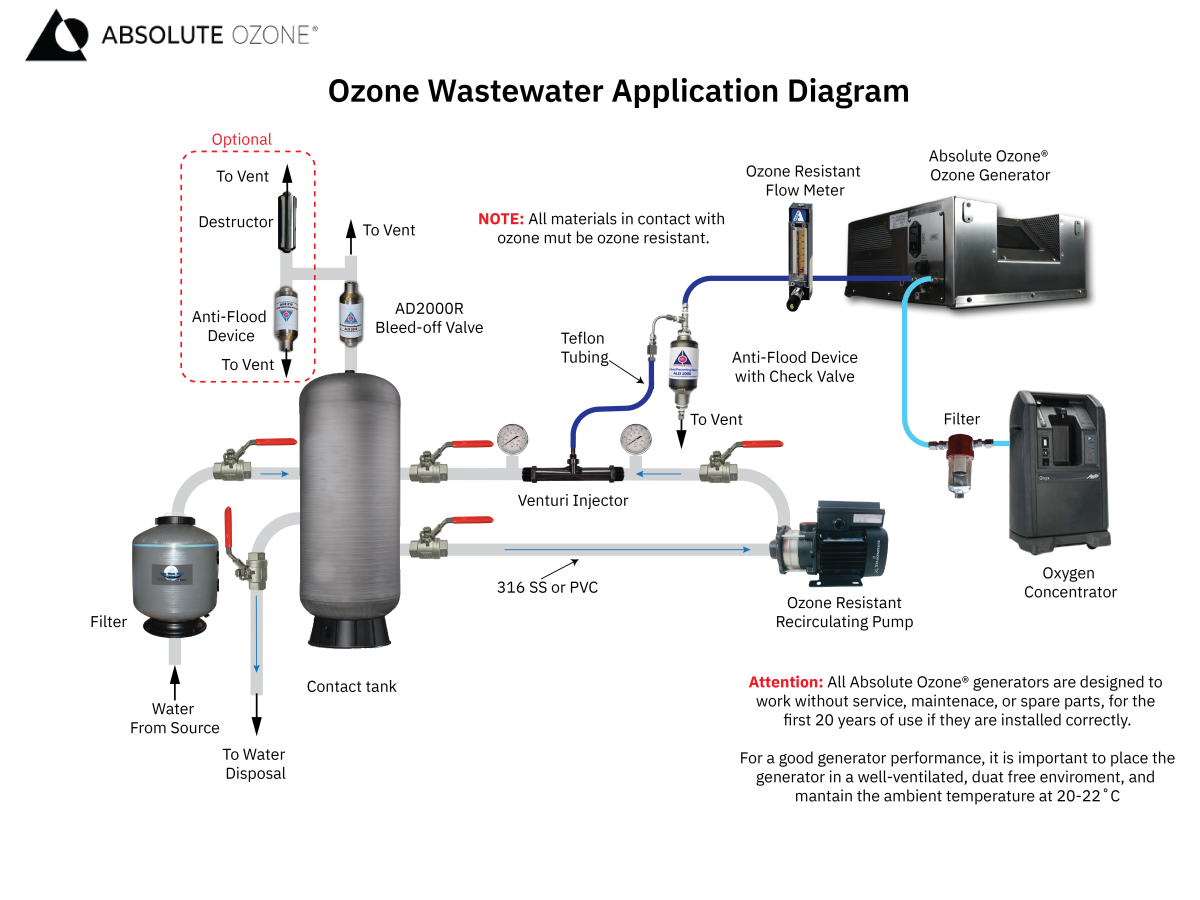
Feed Gas
Oxygen-feed ozone generators are the best choice for all industrial applications.
- We recommended using PSA Oxygen concentrators to produce Ozone
- oxygen concentrator produces oxygen with 90-95% of purity
- Oxygen feed Ozone generator results in a concentration of 4-20 wt.%
- Air feed Ozone generator results in a very lower concentration of 1-3 wt.% (not suitable for ozonation)
Air-feed generators are not suitable for most industrial applications. Remember that only 21% of air is oxygen this significantly affects the ozone concentration that a generator can achieve. In addition, inside the cells, the remaining 78% of the nitrogen will form nitric oxide deposits. In this way, ozone production will gradually decrease after a few months. lear more
Ozone Generators
Absolute Ozone® – ozone generators are equipped with a Dielectric Barrier Plasma Discharge cell. Air-colled Absolute Ozone® generators produce ozone at very high concentrations, typically in the range of 5 to 16 wt.%.
-
Low Oxygen Requirement 2-3 slpm for 1 ppd of ozone
-
High-Pressure Range 10-120 PSIG working pressure
-
PCOP System – Pressure Compensated Ozone Production System
-
Air Cooled, works well at up to +40C, no need to pay for water, water conditioning & air conditioning systems
-
No Maintenance, no serviceable parts, leakproof construction tested at up to 150 PSIG, reliable, less operating cost.
- 5 Years Warranty & “Right on Spec” Performance Warranty, The only warranty that guarantees performance, in the ozone industry
Ozone Mass Transfer
Ozone needs to be dissolved into water. The ozone is partially soluble in the liquid; the solubility efficiency depends on factors such as temperature, pressure and concentration. However, high mass transfer efficiencies can be reached using proper methods and equipment.
Venturi-based mass transfer systems are preferred for dissolving ozone in water due to their simplicity, economy, and effectiveness. Venturi injector has about 90% efficient and can be up to 99% efficient at dissolving ozone into the water.
The Power of Ozone in Destroying Organic Pollutants
There are several mechanisms by which ozone can degrade organic pollutants, including direct oxidation and indirect oxidation through the formation of hydroxyl radicals. In direct oxidation, ozone directly reacts with the pollutant molecule, breaking down the chemical bonds and resulting in the formation of smaller, less harmful compounds.
In indirect oxidation, ozone reacts with water to form hydroxyl radicals, which are highly reactive and attack organic pollutants. This reaction results in the degradation of the pollutant into smaller, less harmful compounds.
The rate at which organic pollutants are degraded with ozone is dependent on several factors, including the nature of the pollutant, the concentration of ozone, and the pH of the water. In general, ozone is most effective at degrading simple organic pollutants such as alcohols and aldehydes, while it is less effective at degrading more complex pollutants such as chlorinated compounds.
Ozone has been shown to be effective at removing a wide range of organic pollutants, including:
- Pesticides: Ozone has been shown to effectively degrade a wide range of pesticides, including organochlorine and organophosphate pesticides.
- Pharmaceuticals: Ozone has been shown to effectively remove pharmaceuticals from water, including antibiotics, hormones, and other drugs.
- Endocrine Disruptors: Ozone has been shown to effectively degrade endocrine disruptors, which are chemicals that can interfere with the endocrine system and cause negative health effects.
- Volatile Organic Compounds (VOCs): Ozone has been shown to effectively remove volatile organic compounds from water, including solvents and other industrial pollutants.
Contact Us if you need more information about your ozonation process

